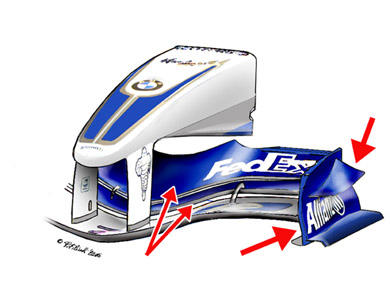Sunday, August 21, 2005
TURKEY GRAND PRIX 2005 - TECHNICAL ANALYSIS
FIA FORMULA ONE - TURKEY GRAND PRIX 2005 TECHNICAL ANALYSIS
In the Turkish heat (which in the end was not as severe as expected) it is crucial that a driver can easily take on fluids. The usual system to provide this has three elements. The drink reservoir is placed low on the side of the cockpit, so as to prevent it raising the car's centre of gravity. It usually contains around two litres of fluid (which means two kilos of extra weight at the start of the race). A pump, activated by the driver via a steering-wheel switch, sucks the liquid through a tube and to the driver's mouthpiece inside his helmet.
McLaren MP4-20 - additional fins
Small but important changes in Turkey, continuing development of the barge boards and lower sidepods. Small, round-edged fins are added both to the outermost edge of the car's flat bottom (lower-right arrow) and to the triangular fin connected to the barge boards (lower-left arrow). The knife-edge profile of the barge boards has also been lengthened slightly (upper-left arrow). All these changes help increase airflow efficiency underneath the car.
Williams FW27 - hidden engine venting
Things are not always what they seem in Formula One racing. In addition to Williams' Renault-style cooling gills, their bodywork in Turkey also has two large slits beside the engine heads, dissipating heat through a vent in front of the rear wheels. These are well hidden by the big upward-curving fin in front of the wheels. The solution prompts recollections of a Jordan exhaust-exit design seen last year. The Williams slits aid cooling without too much airflow disruption in this area.

Ferrari F2005 - winglet and chimney configuration
With the exception of Hungary with its exceptionally high air temperatures, this almost definitive Ferrari configuration has been unchanged in recent races, with the closed chimneys serving not as cooling devices, but as splitters, acting in conjunction with the winglets to control airflow over the rear of the car. For Turkey, the main profile of the winglet partially crosses the chimney. In addition, all bodywork has gone on something of a diet to reduce surface area - in particular the outer side of the vertical fences inside the rear wheels and the rearmost section of the engine cover, over the suspension elements.

Renault R25 - front-wing development


